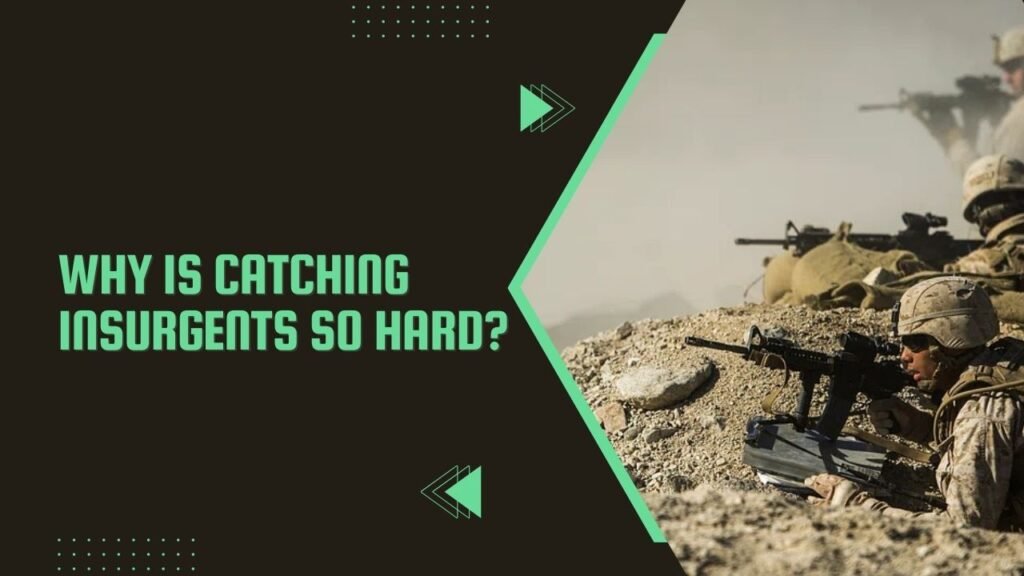Why Is Catching Insurgents So Hard? Catching insurgents is challenging due to their deep local knowledge, enabling them to blend into civilian populations, and their use of decentralized.
Insurgency has long posed a significant threat to governments and societies worldwide.
Insurgent movements, characterized by rebellion against authority, often operate in the shadows, employing unconventional tactics to achieve their goals.
The complexity of insurgency lies in its adaptability, resilience, and ability to exploit weaknesses in conventional security measures.
Understanding why catching insurgents is so difficult requires a deep dive into the strategies they use and the challenges faced by counter-insurgency forces.
This article will explore these challenges and shed light on the multifaceted nature of counter-insurgency operations.
What Is Insurgency?
Definition and Characteristics
Insurgency is a form of rebellion or uprising against an established authority, often a government or occupying power.
Unlike traditional warfare, insurgents rely on irregular tactics such as ambushes, sabotage, hit-and-run attacks, and guerrilla warfare to achieve their objectives.
Their ultimate goal may range from political change to complete regime overthrow. [Why Is Catching Insurgents So Hard?]
What sets insurgents apart is their ability to operate in the shadows, leveraging both military and non-military strategies to gain influence and weaken the opposition.
Historical Context
Insurgencies have been a persistent feature of global conflicts. Historical examples include the Viet Cong in the Vietnam War, the Irish Republican Army (IRA) in Northern Ireland, and the Taliban in Afghanistan.
In each case, insurgents used local support, challenging terrains, and unconventional tactics to resist more powerful adversaries.
More recently, groups like ISIS and Boko Haram have demonstrated the enduring relevance of insurgent tactics in modern conflicts. [Why Is Catching Insurgents So Hard?]
Why Is Catching Insurgents So Difficult? 7 Reasons!
1. Civilian Camouflage
One of the most effective strategies insurgents use is blending into the civilian population. This tactic not only protects them from direct attacks but also complicates the efforts of security forces.
In urban environments, insurgents may live among civilians, using their homes as safe houses and their communities as shields.
This makes it difficult for security forces to conduct operations without risking civilian casualties, which can further erode public trust and support.
2. Decentralized Structures
Unlike conventional military forces, insurgent groups often operate with decentralized command structures. [Why Is Catching Insurgents So Hard?]
They rely on small, autonomous cells that can function independently of one another. This means that even if one cell is captured or neutralized, the broader insurgency can continue unabated.
The decentralized nature of these groups makes it challenging to dismantle their networks entirely, as there is no single point of failure.
3. Geographical Challenges
Geography plays a crucial role in insurgencies. Insurgents often exploit difficult terrains such as mountains, forests, deserts, or urban environments to their advantage.
For example, the mountainous regions of Afghanistan have provided the Taliban with natural fortresses, making it difficult for conventional forces to pursue and engage them.
Similarly, in urban settings, the dense infrastructure offers insurgents numerous hiding places and escape routes, complicating counter-insurgency efforts.
4. Limited Intelligence
Accurate intelligence is the cornerstone of any successful counter-insurgency operation. However, gathering reliable information on insurgent activities is fraught with challenges.
Infiltrating insurgent networks is difficult, as they are often tight-knit and suspicious of outsiders. [Why Is Catching Insurgents So Hard?]
Local informants may be reluctant to cooperate due to fear of retaliation or allegiance to the insurgents. This lack of actionable intelligence makes it harder for security forces to plan and execute effective operations.
5. Propaganda and Local Support
Insurgents are adept at using propaganda to influence public opinion and gain local support.
They often present themselves as defenders of the people, fighting against corrupt or oppressive governments.
By winning the hearts and minds of the local population, insurgents secure crucial support in the form of shelter, resources, and recruits.
This local backing not only sustains their operations but also complicates government efforts to isolate and target them. [Why Is Catching Insurgents So Hard?]
6. Adaptive Tactics
One of the defining characteristics of insurgent groups is their adaptability. They constantly evolve their tactics to counter the strategies employed by security forces.
For instance, when conventional forces develop countermeasures for one type of attack, insurgents may shift to a different method, such as switching from direct confrontations to improvised explosive devices (IEDs).
This ability to adapt quickly keeps security forces on the back foot and prolongs the conflict. [Why Is Catching Insurgents So Hard?]
7. Political and Legal Constraints
Governments often operate under political and legal constraints that limit their ability to combat insurgency effectively.
International laws, human rights considerations, and domestic political pressures can restrict the use of certain military tactics.
Additionally, any actions that result in civilian casualties or damage to civilian infrastructure can lead to public backlash, both domestically and internationally.
These constraints can tie the hands of security forces and provide insurgents with an operational advantage. [Why Is Catching Insurgents So Hard?]
How Governments Combat Insurgency
Military Strategies
To counter insurgency, governments employ a range of military strategies. These include special operations, targeted airstrikes, and surveillance missions.
Special forces are often deployed to conduct precision operations aimed at capturing or eliminating key insurgent leaders.
Airstrikes and drone operations are used to target insurgent strongholds with minimal risk to ground troops. [Why Is Catching Insurgents So Hard?]
However, these strategies require precise intelligence to avoid collateral damage and maintain public support.
Winning Hearts and Minds
Beyond military action, winning the support of the local population is a critical aspect of counter-insurgency efforts. [Why Is Catching Insurgents So Hard?]
Governments often implement social programs, infrastructure development projects, and economic initiatives to improve the quality of life in conflict-affected areas.
By addressing the root causes of insurgency, such as poverty, inequality, and political disenfranchisement, governments can weaken the insurgents’ influence and build trust with the local population.
International Cooperation
Given the transnational nature of many insurgent groups, international cooperation is essential. Countries often work together to share intelligence, resources, and best practices.
International coalitions, such as NATO, play a crucial role in coordinating efforts to combat insurgency. [Why Is Catching Insurgents So Hard?]
Joint military exercises, intelligence-sharing agreements, and capacity-building programs help enhance the collective ability to counter insurgent threats.
The Role of Technology in Modern Counter-Insurgency
Surveillance and Drones
Technological advancements have revolutionized counter-insurgency operations. Surveillance technologies, such as drones and satellite imagery, provide real-time intelligence on insurgent movements and activities.
Drones, in particular, have become invaluable tools for monitoring insurgent strongholds and conducting precision strikes.
Their ability to operate in hostile environments without risking human lives has made them a cornerstone of modern counter-insurgency strategies.
Cyber Operations
In the digital age, insurgents increasingly rely on the internet for communication, propaganda, and recruitment.
Governments are leveraging cyber operations to disrupt these activities. Cyberattacks can target insurgent websites, communication networks, and financial systems, effectively crippling their ability to operate.
Additionally, monitoring online activities can provide valuable intelligence on insurgent plans and movements. [Why Is Catching Insurgents So Hard?]
The Human Cost of Insurgency
The impact of insurgency extends beyond the battlefield. Civilians often bear the brunt of the conflict, facing displacement, loss of livelihood, and the constant threat of violence.
For security forces, the psychological toll of counter-insurgency operations can be significant, leading to issues such as post-traumatic stress disorder (PTSD).
Understanding and addressing these human costs is essential for any comprehensive counter-insurgency strategy. [Why Is Catching Insurgents So Hard?]
See Also: Why Is Geto Dubbed Voice So Bad?
Final Verdict: Why Is Catching Insurgents So Hard?
Catching insurgents is an inherently complex and challenging task. The combination of civilian camouflage, decentralized structures, geographical advantages, and limited intelligence makes insurgency a formidable challenge for governments worldwide.
While military strategies and technological advancements have improved the ability to combat insurgents, the importance of winning local support cannot be overstated.
A successful counter-insurgency strategy requires a holistic approach that addresses both the symptoms and root causes of insurgency. [Why Is Catching Insurgents So Hard?]
FAQs
What makes insurgents different from terrorists?
Insurgents aim to challenge or overthrow governments, often using guerrilla tactics, while terrorists typically use violence to instill fear and achieve specific political goals.
How do insurgents finance their operations?
Insurgents often rely on illicit activities such as drug trafficking, extortion, and donations from sympathizers. [Why Is Catching Insurgents So Hard?]
Which regions are most affected by insurgencies today?
Regions like the Middle East, parts of Africa, and South Asia frequently experience insurgencies due to political instability and socio-economic factors.
What role does local culture play in insurgency?
Local culture can either support or resist insurgent movements, depending on how well the insurgents align their message with the population’s values and grievances.
Can insurgencies ever be fully eradicated?
While difficult, insurgencies can be suppressed through a combination of military, political, and social strategies that address the root causes of conflict.

Hi, I’m Fernando Pham, and welcome to WhyDetails.com! I’m from San Francisco, and I love exploring questions and sharing answers through my blog.



